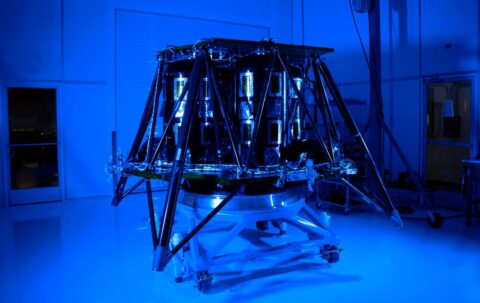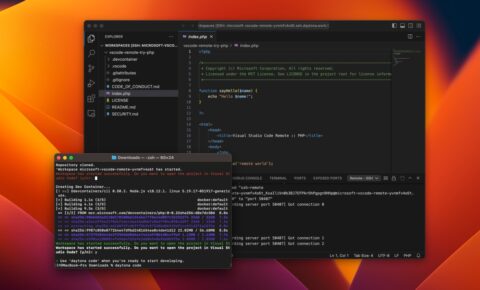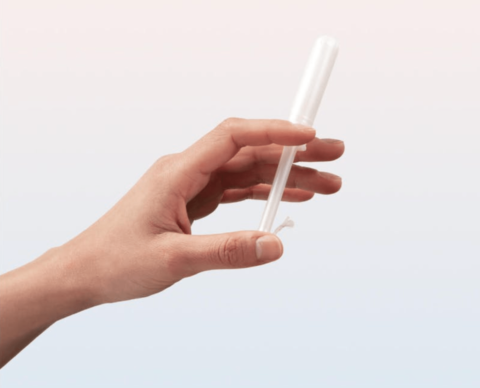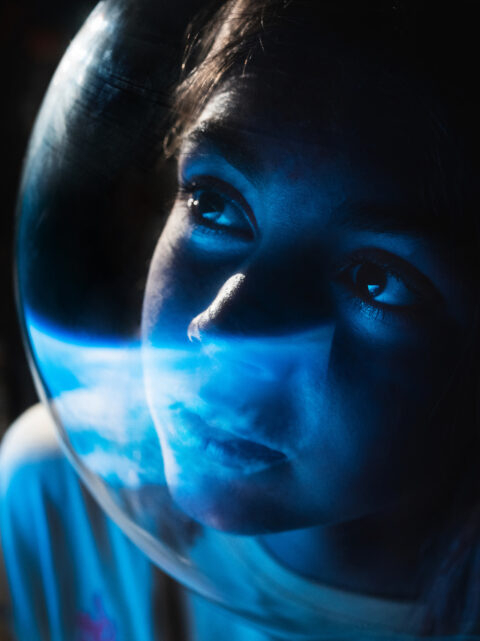Travel just north of Austin, Texas, and you might find yourself in startling proximity to a lunar lander. That’s Firefly Aerospace’s Blue Ghost lander, a 6.6-foot-tall spacecraft that […]
Daytona wants to be an enterprise-grade GitHub Codespaces
A new company is setting out “fill the enterprise void” left by GitHub Codespaces,” with a platform that enables companies to bring all their development environment endeavors in-house. […]
Daye now offers tampon-based STI screening — starting in the UK
UK femcare-turned-gynaecological-health startup, Daye, has expanded its tampon-based home screening service to add STI testing. The startup is billing this “non-invasive screening” service for sexually transmitted infections as […]
Best Apple deal: 2017 iPad Pro bundle for just $290
Save on a refurbished 2017 iPad Pro, including a tempered glass screen protector, case, and charger, at the Mashable Shop.

TL;DR: Through Nov. 9, you can pick up a refurbished 2017 iPad Pro (256GB, WiFi) for only $289.97 instead of $679 — that’s a savings of 57%. Plus, it comes with a tempered glass screen protector, case, and charger.
In this on-the-go world, a tablet is an easy way to take work and entertainment with you. Whether you commute for work or travel often (like going to see family for the holidays), a tablet provides the portability required to keep it convenient. Before the Black Friday grind, this refurbished Apple iPad Pro and accessory bundle is on sale for $289.97 (reg. $679), but only until November 9.
From the not-so-distant 2017, this iPad Pro runs a 2.3GHz Apple A10X Fusion processor for a smoother performance. It has 4GB RAM and an ample 256GB of storage to multi-task. And if you want to watch movies, shows, or videos while you’re getting to where you want to go, the 10.5-inch screen features an LED-backlit touch-sensitive Retina display to make it an enjoyable experience.
To help you stay connected, it comes with WiFi and a 7MP FaceTime HD front camera for video chatting with friends, family, and colleagues when you can’t be there in person.
Meanwhile, the 12MP iSight rear camera captures life’s special moments in photos and videos. And this iPad Pro features ProMotion technology, which allows for a faster, smoother 120Hz animation.
It comes with a grade “B” refurbished rating. This means that while it works like new, it may have light scuffing, scratches, or dents on the bevel/case. However, buying refurbished means less e-waste, which is better for the environment.
Don’t compromise on quality, performance, or value for yourself or your loved ones. Elevate your digital lifestyle with the refurbished iPad Pro, complete with accessories.
Get the refurbished Apple iPad Pro 10.5″ 256GB for just $289.97 with accessories (reg. $679) until November 9th at 11:59 p.m. PT.
Prices subject to change.

Opens in a new window
AI’s not the only sector dodging the funding slowdown
A tougher fundraising environment reveals which companies and sectors investors have real conviction in, and which areas aren’t attractive outside of a bull market. AI startups dominated dealmaking […]
Google DeepMind’s robotics head on general purpose robots, generative AI and office WiFi
[A version of this piece first appeared in TechCrunch’s robotics newsletter, Actuator. Subscribe here.] Earlier this month, Google’s DeepMind team debuted Open X-Embodiment, a database of robotics functionality created […]
Could humans have babies in space safely? Here’s what we know.
Some scientists seek to solve the potential problems caused by microgravity and cosmic radiation for human reproduction in space.

The recently married couple tip their bellhop, drop their suitcases, and breathe out a sigh as they fall back on the bed. They wanted a gramworthy honeymoon, and for a few million dollars, they’ve got it.
Once their initial travel sickness wears off, they’re feeling as frisky as any other newlyweds. Perhaps the only thing that could distract them from the marital act now is that incredible cabin view of infinite space, and the faint reminders of civilization glinting at them from Earth, some 250 miles below.
If space hotels come to fruition in the coming years or more realistically decades, cosmic vacations won’t be a sci-fi fantasy. Even without hotels, longer orbital space flights all but guarantee tourists opportunities to join the 60-miles-high club. It’s the “souvenirs” these couples could bring home that have a few researchers worried — enough to publish a public report on the risks associated with human conception in the future space tourism sector.
Bottomline: No one knows whether babies could be conceived in space without detrimental consequences to their health — there simply isn’t enough research. While professional astronauts likely have a good grasp on why they shouldn’t set out to make a starchild, less-informed travelers might not demonstrate the same level of restraint.
“It’s going to be a very strong magnet for these couples. They’ll want to be maybe in the history books, like, ‘Hey, we created the very first naturally conceived baby in space,'” said Egbert Edelbroek, CEO of the space research company SpaceBorn United and one of the co-authors, “but they shouldn’t want to.”
The paper published in April captured some buzz — even some snickers from late-night host Jimmy Kimmel, who called them “nine very lonely authors” — for broaching a little-discussed issue. Though the intent was to get the burgeoning space tourism sector to think about how to discourage space sex that leads to pregnancy (Not sex altogether, one of the researchers assured Mashable. They’re not prudes.), the topic brings into focus an existential problem: How could humans ever leave Earth in the event of a global crisis if people don’t know how to procreate in space or any other world?
SpaceX founder Elon Musk has said his ultimate vision is to use a fleet of Starships to send 1 million humans to Mars by 2050. But if those pioneers die off because they can’t have children, or healthy children, what’s the point?
“They’ll want to be maybe in the history books, like, ‘Hey, we created the very first naturally conceived baby in space,’ but they shouldn’t want to.”

Credit: Steven Hobbs / Stocktrek Images via Getty Images illustration
Gravity and radiation levels pose challenges
In spaceflight, humans are exposed to different levels of gravity — sometimes less, sometimes more. Think about those roller coaster warnings at amusement parks prohibiting pregnant people from riding. They’re in part because extra G-forces can lead to premature separation of the placenta from the wall of the uterus.
On the other hand, little or no gravity like on the International Space Station presents its own challenges: For the past 60 years, NASA has been working on how to keep adults healthy in weightlessness. As it is, astronauts are expected to exercise at least two hours a day on a treadmill or stationary bicycle to combat bone and muscle deterioration.
Research also suggests that cosmic radiation, like other sources of radiation, could damage DNA, reproductive organs, and sperm and egg cells. In women, depending on the amount of exposure, that might mean sterility, ovarian failure, and cancer, which may lead to early menopause or death. In pregnancy, the risks could include miscarriage and premature births. For men, too much radiation could also lead to reduced sperm count or sterility, though some scientific findings indicate sperm could be safely stored in space for a time.
When it comes to embryos and fetuses, the news is just as grim. Radiation can cause growth delays, cognitive impairments, deformities, and higher risks of newborn death.
“We’ve got some ideas that there will be quite a lot of negative issues in the development of bones and musculature,” said David Cullen, professor of astrobiology and space biotechnology at Cranfield University in the United Kingdom. “And all these other kinds of things inherently are driven by a combination of genetics, biochemistry, and responses to the local environment. So if you change that local environment, you expect all of those development states to be affected in some way — and, most likely, in a negative way.”
Want more science and tech news delivered straight to your inbox? Sign up for Mashable’s Light Speed newsletter today.
Startup seeks to make reproduction in space work
The Dutch entrepreneur Edelbroek wants to make human reproduction possible in space by first taking sex out of the equation. His company, SpaceBorn United, may be the first in the world planning space-based research on in vitro fertilization, though it’s hard to know what the often-secretive Chinese government may be doing.
Through a series of missions, the startup wants to conduct experiments observing the effects of partial gravity on embryo development. The company, which has about 30 mostly part-time employees now, would start with animal studies before advancing to human cells. In August, SpaceBorn United partnered with Independence-X, a Malaysian space exploration company, to conduct a suborbital drop test of its re-entry capsule containing biological samples.
So far SpaceBorn United has developed a miniature IVF and embryo incubator using microfluidics technology. The prototype hardware, which looks like a CD, has multiple tiny channels that hold sperm and eggs. The disc spins to simulate different loads of gravity while the device automatically impregnates embryos. Now the venture is working with a German company, Atmos Space Cargo, to launch mouse embryos on an orbital test flight by the end of next year, Edelbroek said.

Credit: SpaceBorn United illustration
The logistics of doing these experiments are complicated. Because the team needs to work with freshly harvested female cells, the company must have last-minute access to the rocket payload, making ride-sharing programs unfeasible. The cells only remain fertile for four to six hours.
But private industry will have to lead the way on space reproduction research, he said, because NASA and other government space agencies have onerous political challenges to navigate before engaging in such studies. In the United States, for instance, sex is already a taboo subject. Add on top of that the nation’s complex culture war over reproductive rights, and the hurdles are monumental. Experts say the U.S. space agency isn’t likely to get Congress on board with funding such endeavors.
They “can only work with baby steps — with fruit flies and frog eggs and some rodents — and never, never even speak about doing it with human reproductive cells,” he said.

Credit: Tom Trower / NASA Ames Research Center
Most of the company’s investors are in the fertility sector because of the potential to improve assisted reproductive technology on Earth. They’ve also received interest in collaborating from neophyte spacefaring nations, such as the United Arab Emirates, that may want the prestige of being involved in a first like human embryo conception in space.
In the same vein as the space burial market, SpaceBorn United anticipates there will be affluent customers interested in paying for space-fertilized babies long before humans are even living somewhere beyond Earth.
“We’ve had other suggestions, like space cats and dogs,” Edelbroek said.

Credit: SpaceBorn United
Ethics of human reproduction research in space
Though the ultimate goal may be to one day make natural conception and childbirth possible in space, doing so won’t be possible anytime soon, said Alexandra Proshchina, a neuroscientist at the Petrovsky National Research Center for Surgery in Moscow.
She and her colleagues have worked on animal reproduction studies in microgravity through several missions organized by the Institute of Biomedical Problems. In the 1990s, they participated in a Russian-Canadian experiment on the BION-10 biosatellite involving clawed frog tadpoles and an 11-day Russian-American experiment on space shuttle Atlantis centered on the development of rat embryos.
“(They) can only work with baby steps — with fruit flies and frog eggs and some rodents — and never, never even speak about doing it with human reproductive cells.”
Then in 2014, along with Rustam Berdiev, a physiologist at the Lomonosov Moscow State University, they performed the world’s first attempt to mate ornate day geckos in spaceflight on the Russian FOTON-M4 satellite, though the lizards died due to difficulties with the mission. The team has since started preparing an orbital experiment involving veiled chameleon embryos, but the project has stalled, in part because of funding challenges, researchers told Mashable.

Credit: DEA / L. RICCIARINI / De Agostini via Getty Images
During pregnancy, women adapt to changes in body mass, hormone levels, metabolism, and a host of other biological processes that put significant strain on their bodies. Even astronauts at peak fitness get spacesick, said Proshchina, who, along with morphologist Victoria Gulimova, responded to Mashable in writing to overcome translation issues.
“Subjecting pregnant women to such physical stress is not very humane,” Proshchina said. “Moreover, it would be unacceptable to put the baby at risk.”
Even if a baby could be delivered safely in space, scientists know even less about the impacts of the space environment on children and teenagers, said Alex Layendecker, a former Air Force space operations officer with a doctorate in human sexuality. He has recently founded the Astrosexological Research Institute, a nonprofit organization aimed at facilitating studies of sex and reproduction in space.
Cell division is more rapid in children than adults. When ionizing radiation penetrates a human body, it destroys bonds and can lead to cancer. If a child were to develop cancer, it might spread faster in outer space conditions than it would for an adult, he said.

Credit: A. Martin UW Photography via Getty Images
In terms of ethics, taking a minor away from the planet, even just for a space cruise, would cross a line, given the lack of data: Children can’t provide informed consent, yet their lives likely would be at a much higher risk of negative impacts, he said.
Whether a human conceived and born in space would be able to adapt to other planets is a looming unknown. It’s not even clear whether such a child could survive on Earth after coming home, said Gulimova, who also works at the Petrovsky National Research Center for Surgery.
Or, would the first long-duration space journeys crewed with astronauts and their descendants have to be planned as one-way trips?
“There are many questions, and many more ground-based and orbital experiments that will have to be carried out, before happy parents on board the spacecraft hear the first cry of the first citizen of the Universe,” she said.
If your startup doesn’t seem impossible at first, it’s not hard enough
Welcome to Startups Weekly. Sign up here to get it in your inbox every Friday. Startups exist to solve complex problems, not to be a quick moneymaking scheme, […]
This $169 device can put your iPhone in a reboot loop. Here’s what you can do.
A tiny $169 device can send iPhones and other phones into a reboot loop. There’s no immediate fix, but you can take precautions.

A tiny device can be used to put your iPhone, and perhaps Android phones as well, into an endless reboot loop — and while there is a way to mitigate the attack, it’s far from ideal.
The device is called Flipper Zero and is typically used for penetration testing, meaning security experts use it to test another device’s wireless security. It’s not exactly obscure; it can easily be bought online for $169 in the U.S. or €165 in Europe.
Described as a “portable multi-tool for pentesters and geeks in a toy-like body,” Flipper Zero can interact with various types of wireless systems, including garage door remotes, TVs, NFC readers, RFID readers, and Bluetooth devices.
The device has been around since 2020 (we actually covered it back then), but Ars Technica and TechCrunch have recently highlighted how Flipper Zero can be used to essentially incapacitate an iPhone by sending an endless flurry of Bluetooth requests. On the victim’s iPhone, these could look like a request to connect with a TV, which keep popping up until the phone eventually reboots. This is not a new type of attack, but Flipper Zero is cheap, small, portable, and makes it a lot easier to do.
Security researcher Jeroen van der Ham said he experienced this attack himself. He then set out to replicate it himself in a controlled environment, and he managed to crash an iPhone, though the attack only fully worked on iPhones running iOS 17 or newer.
Here’s the problem: You cannot permanently deny these types of request on an iPhone. You can deny the connection, but the requests will keep popping up. The only thing you can really do at this point is to turn Bluetooth off completely, but then your wireless headphones and other Bluetooth accessories will be disconnected from your iPhone, which is hardly ideal. Note that you cannot just switch Bluetooth off in the Control Center; you have to turn Bluetooth off in the phone’s Settings to mitigate the attack. Van der Ham says he contacted Apple about the issue but did not hear back from the company.
There are reports saying that Flipper Zero can be used to perform a similar attacks on other devices, such as Android phones and Windows devices, though it’s unclear whether it can be used to crash them. Additionally, Android phones do have an option to turn off notifications for Bluetooth connection requests making this a lot less of a nuisance.










